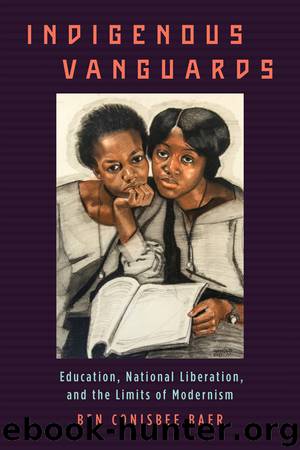Indigenous Vanguards by Ben Conisbee Baer;

Author:Ben Conisbee Baer;
Language: eng
Format: epub
Publisher: Perseus Books, LLC
The story of The Plumed Serpent is that of Kate Leslie, an upper-middle-class, white European visitor to Mexico who becomes erotically embroiled in a feudalistic (counter)revolutionary vanguard movement. The movement presents itself as a countercolonial “return” of precolonial cultural systems (“the old gods”) to Mexico (PS passim). The Quetzalcoatl movement is the novel’s main emblem of a politicized and “positive” primitivism, a primitivism that seeks to ground social agency in the present by mobilizing the ghosts of the precolonial past. Refiguring aspects of Mexico’s revolutionary millenarianism, Lawrence portrays religion as the code of the movement’s bid for agency, and dramatizes its spread throughout the country in terms of didactic texts and performances.26
Kate Millett has written that “The Plumed Serpent is the story of a religious conversion,” and this remains an instructive, albeit characterologically focused, way of reading the novel.27 The Plumed Serpent tracks the signs of “conversion” in the protagonist’s subjectivity, but also graphs the success or failure of broader processes of transformation discontinuous with her consciousness. The narrative’s desire is to show how Kate the writer-actor is made by entering an alien collectivity, as Kate the individualist reader-tourist is unmade; but the representation of this event is persistently blocked. The novel thereby proves itself as much invested in depicting a failure of articulation as it is in imagining its success. Thus, rather than effecting an expansion of the protagonist’s restricted vision as she enters a new world, purportedly to become a writer-actor within it rather than a reader of it, The Plumed Serpent hyperbolizes its initial impasses so as to question the value of the very “change” or revolution it depicts. In its ironic staging of an arrivante protagonist persistently misrecognizing or misreading the revolutionary signs around her, The Plumed Serpent places itself in a literary genealogy that includes forebears such as Flaubert’s Sentimental Education (1869). As in Flaubert’s novel, the depiction of sentimental education (or conversion) stalls on its own self-resistance.28 And, as in Flaubert, the turning “world” surrounding the self-obsessed protagonist must be read beyond the limited frame of that protagonist’s focalization. That “world” is also subject to transformations as complex as those depicted within the mental theater of the character. The interest of the work lies in the disjunctions and articulations between these two intermittently intersecting spaces of narration established by it, and its contrasting treatments of collective and individual transformation.
The scene of The Plumed Serpent is the scene of revolution and, to distort Régis Debray’s formula, the “counterrevolution in the revolution.”29 The novel was written in the wake of the Bolshevik Revolution in Russia and the failed Easter Rising in Ireland in 1916, both of which are marked as signifiers behind The Plumed Serpent’s narrative present of the Mexican Revolution. The setting is Mexico in the early 1920s, and the country is still in the throes of militant upheaval following the Revolution of 1910 and its radicalization in 1917 after the events in Russia.30 The revolution in the revolution depicted by The Plumed Serpent is also against the revolution.
Download
This site does not store any files on its server. We only index and link to content provided by other sites. Please contact the content providers to delete copyright contents if any and email us, we'll remove relevant links or contents immediately.
| Ancient & Classical | Arthurian Romance |
| Beat Generation | Feminist |
| Gothic & Romantic | LGBT |
| Medieval | Modern |
| Modernism | Postmodernism |
| Renaissance | Shakespeare |
| Surrealism | Victorian |
4 3 2 1: A Novel by Paul Auster(12333)
The handmaid's tale by Margaret Atwood(7711)
Giovanni's Room by James Baldwin(7256)
Asking the Right Questions: A Guide to Critical Thinking by M. Neil Browne & Stuart M. Keeley(5712)
Big Magic: Creative Living Beyond Fear by Elizabeth Gilbert(5681)
Ego Is the Enemy by Ryan Holiday(5350)
The Body: A Guide for Occupants by Bill Bryson(5033)
On Writing A Memoir of the Craft by Stephen King(4893)
Ken Follett - World without end by Ken Follett(4686)
Adulting by Kelly Williams Brown(4536)
Bluets by Maggie Nelson(4515)
Eat That Frog! by Brian Tracy(4484)
Guilty Pleasures by Laurell K Hamilton(4395)
The Poetry of Pablo Neruda by Pablo Neruda(4066)
Alive: The Story of the Andes Survivors by Piers Paul Read(3998)
White Noise - A Novel by Don DeLillo(3982)
Fingerprints of the Gods by Graham Hancock(3966)
The Book of Joy by Dalai Lama(3947)
The Bookshop by Penelope Fitzgerald(3812)
